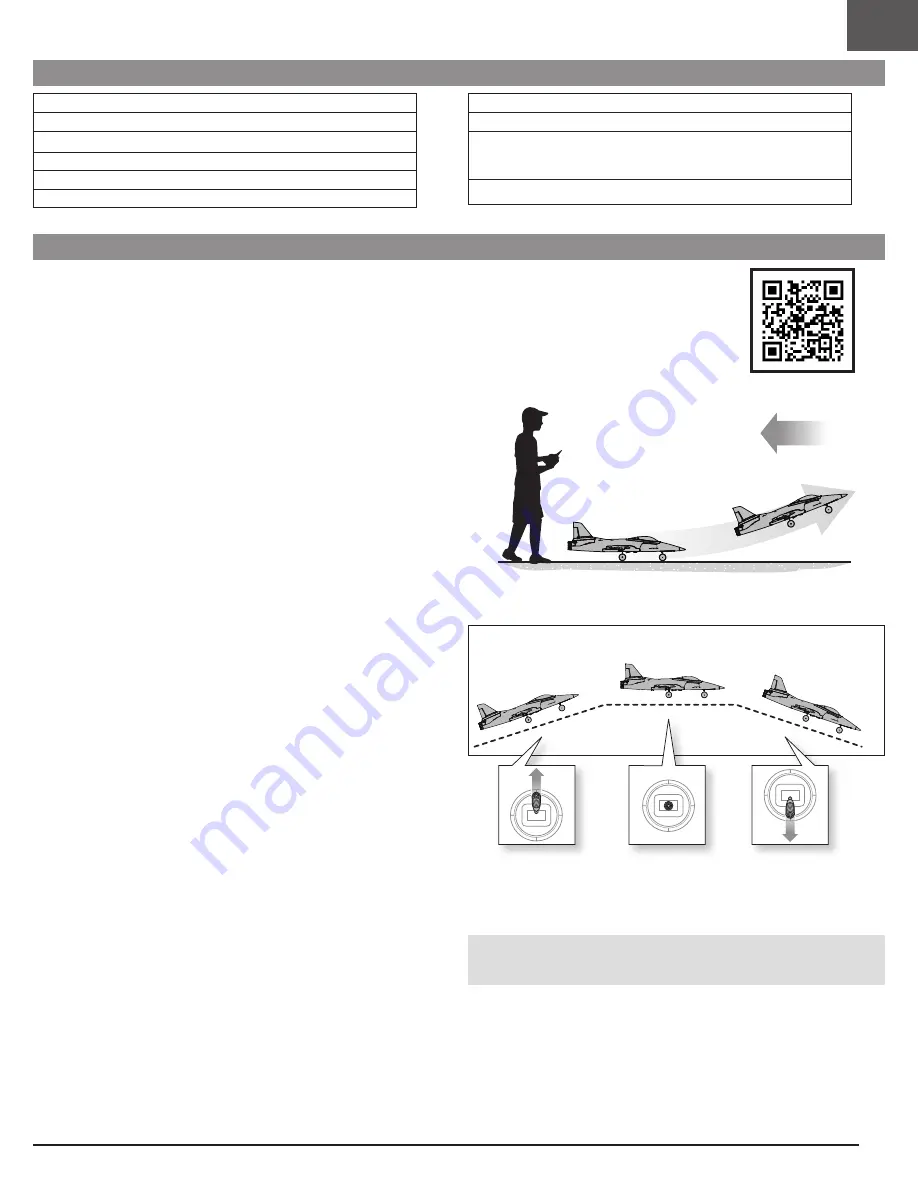
15
EN
In Flight
Continue to climb into the wind at full throttle, until the aircraft reaches about
50 feet (15 meters). Gradually turn the aircraft away from you while still
maintaining altitude. Begin a turn by banking the aircraft slightly with the aileron
stick. Gently pull back on the elevator stick to pull the aircraft around the turn and
to maintain altitude. When the aircraft reaches the heading desired, simply apply
the opposite aileron to level the wings and ease off the elevator.
Climb to about 200 feet (60 meters) and reduce the throttle to around 50%. Adjust
the throttle up or down to maintain altitude. Try not to get the aircraft too high or far
away, making it difficult to see.
As you are flying:
• Fly at a high enough altitude to give yourself time to react to what the aircraft
is doing.
• Make small and gentle stick movements to see how the aircraft responds.
• Practice flying in large circles, high off the ground. Flying with the nose pointed
toward you is one of the hardest skills to master when learning to fly. Flying in
circles will give you experience viewing the aircraft from all angles.
• If you lose orientation of the aircraft, press and hold the Panic Recovery button
and release the sticks. The aircraft will return to level flight. Release the button
to continue your flight.
IMPORTANT:
Although the Habu STS has a very large flight envelope, unlike a
more conventional propeller driven aircraft, the electric ducted fan does not have
air from the propeller moving over the control surfaces at slower speeds. This
aircraft depends on airspeed to maintain control responsiveness. Allowing the
aircraft to fly too slowly can cause loss of control effectiveness.
NOTICE:
If a crash is imminent, activate throttle cut or quickly lower the throttle
and throttle trim. Failure to do so could result in greater damage to the airframe,
as well as damage to the ESC and motor.
Slowly advance
the throttle stick.
Wind
When properly trimmed, the aircraft’s wing design causes the aircraft to climb at
full throttle and descend at reduced throttle without the use of elevator.
50% throttle
Full throttle
Reduced throttle
Flying
Preflight Checklist
Find a safe open area to fly.
Charge the flight battery.
Install a fully charged flight battery in the aircraft.
Make sure all linkages move freely.
Check the Center of Gravity (CG).
Perform the control direction test.
Perform a radio system range test.
Plan flight for flying field conditions.
Set a flight time for:
4-6 minutes using a 3000mAh 3S battery pack.
8-10 minutes using a 4000mAh 3S battery pack.
Have Fun!
Flying Video
This aircraft is relatively easy to fly and helps you apply beginner skills to flying;
however, we recommend you get help from a qualified flight instructor for your first
radio controlled flights. Some model flying clubs provide flight training at their flying
fields. Find a nearby flying club through your local hobby shop. In the U.S., visit the
Academy of Model Aeronautics at www.modelaircraft.org for more information on
clubs and flight instruction.
Takeoff
Set the flight mode switch to Beginner mode (switch B, position 0) for your first
flights. Set a flight timer for 5 minutes. Adjust the flight timer for later flights,
depending on your flight battery choice.
Position the aircraft on the runway, facing into the wind. Slowly advance the throttle
to start the takeoff roll into the wind. Small rudder inputs may be required to keep
the aircraft headed straight. As the throttle is advanced and sufficient speed is
attained the aircraft will begin a slow climb out.
TIP:
Rudder / nose wheel control throw is automatically set for taxi mode in
beginner mode when on the ground and under 6 meters of altitude. This provides
more control to taxi the aircraft and yaw control during landings. Once airborne,
rudder control throw is automatically reduced to beginner flight mode.
Scan the QR code for a link to a video with tips to help
successfully fly the aircraft.















































